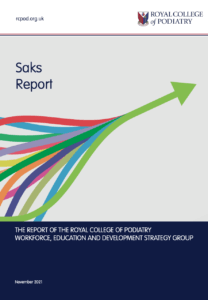PODIATRY UNDER THE MICROSCOPE
 An act to reveal the truth may not always be comfortable but I decided to look at the new SAKS report published during November. (CFP) usually looks at clinical concerns and patient cases but does not shy away from peripheral politics where podiatry’s development and future progress is at stake. There is no intention to replicate the report but to concentrate on the critical concern as to why podiatry is failing to make an impact given so much positive development. Members can access the full account, which echoes five features that focus on the needs of the profession of podiatry – its purpose, its people, its place, its potential and its performance. This article focuses on the disparity of a profession and why it could be better at ground level.
An act to reveal the truth may not always be comfortable but I decided to look at the new SAKS report published during November. (CFP) usually looks at clinical concerns and patient cases but does not shy away from peripheral politics where podiatry’s development and future progress is at stake. There is no intention to replicate the report but to concentrate on the critical concern as to why podiatry is failing to make an impact given so much positive development. Members can access the full account, which echoes five features that focus on the needs of the profession of podiatry – its purpose, its people, its place, its potential and its performance. This article focuses on the disparity of a profession and why it could be better at ground level.
Who is behind the SAKS REPORT?

Overview
As a 43-page indexed report, this is short but no less detailed in modern-day terms, being well written and concluding with seven recommendations with sub-divisions. When preparing this article, the report was available as an open-access document in summary; only members of the Royal College of Podiatry could access the full report. Compiled by Professor Mike Saks, an independent academic interested in professional development and supported by a list of luminaries from the four nations, there was a mixture of skills sets covering key areas of podiatric practice. The report is based on the self-recognition of an organisation that has gained Royal status yet fails to meet demand and interest from those seeking a new career. In short, the profession is decaying exponentially at one end and expanding at the other with an ever-widening gap. The defective gap has the overall effect of causing stagnation in a manner that prevents the smooth progression of development that other allied medical health professions have not experienced. One of the problems causing stagnation has been that high academic achievement and clinical expertise have met medical and scientific standards only at one end of the professional body. While at the other end of the spectrum of practice, a fair percentage of podiatrists have remained undeveloped in practice attitudes to such an extent that unregistered practitioners providing essential foot health support have caught up.
The demand for foot health care and management can no longer be met in the community. The most poignant point is that while the NHS recruitment and retention is poor, the independent commercial sector is inefficiently organised and delivers a sub-optimal service in many parts of the UK. To the uninitiated, Health Education England plays a role behind the scenes and acts as a driver for change. Elsewhere several interested bodies have started to collaborate with the Royal College, not least as there is a recognition of a shortage of manpower in delivering foot health to residents in the UK.
| Recommendations | Summary |
| 1. General recommendations | Team working & reducing insularity but enhance jurisdictional role-specific to the activity of podiatry |
| 2. Scope of podiatry | Expansion of role and to become first-contact practitioners |
| 3. Organisational and support structure of podiatry | Independent solo practice restructuring and developing more specialism |
| 4. Increasing the sustainability of podiatry | Improving methods for recruiting |
| 5. Patient and public involvement in podiatry | Direct engagement with the public should be improved. |
| 6. Publicity and lobbying | Marketing: closer work with the media and other professionals and embracing patient self-care. |
| 7. Future research | Seeking new opportunities and new funding routes after Brexit. |
The table above illustrates the areas upon which recommendations have been considered. Twenty-eight recommendations follow on from a SWOT analysis that identifies the strengths of the profession against weaker areas. Balanced against strengths and weaknesses within the report, the threats and opportunities might give the impression that the discipline of podiatry has been asleep for a quarter of a century. Of course, this is unfair because not all sectors have been dormant. Research has evolved with a slow funding stream, establishing professorial seats alongside growing academic rigour.
Nevertheless, there is a sense of gloomy recognition that the public still doesn’t know what podiatrists do despite all warnings. Podiatry fails to slip into an obvious pigeonhole within the British healthcare system when it comes to the average person on the street. The cosy view that podiatry has a place in diabetic care reveals complacency because so much more could be achieved. Peel away some of the vinyl covering from all the old worn out cherries that the report has recaptured, and we find some fairly penetrating new and prominent areas where podiatry remains woefully unprepared. Indeed COVID is mentioned, and some podiatrists made valued contributions using their skills outside the specific arena of their designated field. However, skill transfer can only emerge when each clinician expands their scope rather than slavishly following a routine that dates back to the early days when registration first commenced.
Mind The Gap!
A follow up article for podiatrists trying to make a decision over new membership plans at the Royal College of Podiatry. Which side of the gap do you sit? Should membership be widened? Will this help you fill in the RCP survey? Make your voice count. Follows on from the SAKS REPORT review by ConsultingFootPain – independent journalism for podiatrists. Also find out the true difference between a chiropodist and podiatrist?
Scope & First Contact Practitioner
Saks picks this up nicely but goes further. Podiatrists have “…clinical training to develop their critical decision making and reflective practice, knowledge and skills. As trained diagnosticians with independent ability to diagnose and treat without referral from other healthcare practitioners, a podiatrist education focuses on multi-disciplinary approaches to the management of complex multi-morbid patient groups across a range of service settings-supporting people with a wide variety of foot and/or lower limb disorders, diseases, and complications and helping populations to remain systemically healthy, mobile and active.”
This lengthy statement suggests a cosy well-defined role, and yet, in reality, those that meet these conditions are far from the majority. The truth is that this is an aspiration that all podiatrists should drive toward, and yet the painful truth is the skills set is so mixed that a detailed analysis would reveal a different picture. As the report states correctly, the HCPC has its interpretation of the role of podiatry and feels the impression of podiatry is narrow. However, it might be unfair to say that the HCPC does not allow professions to stretch their scope. Podiatric surgery is an example as evidence of successful enlargement. Relating to the ideals of becoming first contact practitioners, we meet the term SCOPE. There is an undeniable fact that general practitioners (of medicine) are under considerable pressure. There has never been a stronger case for submitting to the Health Secretary that podiatry could be better integrated with primary care as the first contact for lower limb health and wellbeing. Having a wider remit of care and attention would be essential and accelerate the recognition that podiatry could contribute positively.
The scope of podiatry requires a broader definition and should directly synchronise with higher education. However, there is little emphasis in the report covering the BSc curriculum or whether this should be reviewed to meet higher educational needs. It would seem while this is an important platform, little mention is made for making the changes necessary. For example, universities could expand the clinical role for their students but do not have sufficient placement exposure in the areas where the most important skills sets are required. One might ask how has this happened that those with expertise are not used to shore up deficit. A chicken and egg paradigm exists, and the only way of tackling this is to ensure clinicians and Universities work together for change. The method of analgesia Part B in the seventies was slow and clunky, but it worked. With better resources, a programme could close the gap in podiatric scope to meet these needs; surely the Universities have the capacity?
Expanding independent prescription medication has been one area, and this uptake must be encouraged and expanded. The remaining statement worth highlighting involves extending the scope “beyond simply feet and/or ankle to highlight its more holistic and positive role in service and other contexts.”
With the parallel concerns about medical practitioner uptake levels in a GP practice, podiatrists could take on the very role that Saks recommends because the outcome must achieve faster triage and action. Dermatology, vascular limb flow studies, neurological changes and organ failure can be picked up within the framework associated with alterations in gait patterns, skin manifestations and recognition of organic and mental disease. Allied to this aspiration, lower and upper limb (hands and arms) cancers could be screened as part of an essential programme now that there is a strong appetite for higher-level skin management and diagnosis. All USA podiatrists know how to use a stethoscope. The resistance to embarking on medical baseline practice must be discouraged now that Advanced Life Support and Intermediate Life Support courses are accessible with cannulation skills. A thorough programme to upskill podiatrists should be part of career development and undergraduate investment. This omission is not down to the professional body, for the professional body is the membership that must drive the Royal College for change. If anyone feels critical toward upskilling, the report points out the need to recognise transformational changes in society, making better use of technology and virtual consultations. From the nature of the overall recommendations, it is clear that one proposal dovetails with another. As the tree of knowledge grows, one can see each recommendation as a roadmap with many offshoots. All roads finish at the central junction and interconnect. If each of the roads fails to meet in synchrony, then the overall plan will be weakened. The idea of cherry-picking is not an option, and all parts are dependent on the success of others.
A student who sees the profession as a nail and corn trimming service will not be impressed. However, a student who sees primary care professionals utilising medically skilled techniques embedded to manage a wide range of problems beyond feet will feel that they are entering a great profession steeped in medical science, offering greater stimulation. Unfortunately, the profession has failed to persuade the public that it delivers an equitable medical service, and this will continue if change does not arise.
Making painful choices
The report does not dissuade the Royal College to ignore the mature and educationally skilled. Still, it does point out hidden concerns that failing to recruit younger students has dangers with an ageing workforce. The workforce is mixed, but younger students with a better gender balance and diversity are essential for sustainability. Developing specialist skills and reaching a high career apex is harder when commencing podiatry from the age of 35-45 because there are often factors that limit opportunities that younger podiatrists have; the matter of an uncluttered life at the start of their career. A healthy profession has a broader balance of people, and this is recommended. There are two other critical areas of note. The first is recognising the value of patient/public and lay involvement and offering a more comprehensive self-management approach to foot problems. The second area involves adopting better management within the independent sector by rebalancing how sole owner businesses operate with the option of utilising support from those who can provide basic skills, e.g foot health practitioners and clinical assistants. Hence, there is limited loss of service provision to competitor professions. In the first case, the profession has paid lip service to external viewpoints. Many professions have encouraged patient participation to develop and expand services. While appearing more inclusive, the value of real-world opinions in society can be better embedded in forward development. Open voices can reduce hostility due to misunderstanding. Laypeople can often ensure professions deliver better clarity with simple language. Spokespeople from this sector can provide better media promotion than professionals as they are unfettered by the restraints of professionalism.
The second element of concern and in need of review is how podiatry is delivered in the community through lone or sole practitioners. The road map shows that links to the NHS, GP practises, meeting demand in a timely manner form part of the problem. Isolation has been the podiatrist’s bête noire since the profession was given autonomy. This aspect of practice has been counter-productive. Group practices are far more robust and can fill in deficits due to holidays, sickness and days out for professional development. Developing brand-name practices forms successful business and brings together multi-skills where the practice offers a broader range of management, allowing individuals to develop their niche. The threats from unregulated competition should have been predictable and is a sign if not a symptom of gaps appearing, which could be closed by better managerial performance. As the report is circulated and read by those members of the Royal College of Podiatry, it would be interesting to know what members of the Institute of Chiropodists & Podiatrists view would be? Do they see the same issues as there are so many overlaps for both organisations?
Making it happen
This report is excellent as it offers something for all areas of practice, including the NHS, which in itself is haemorrhaging a workforce. However, writing a document is one thing while implementing all these recommendations is unlikely to be in the gift of the Royal College alone. The absolute truth is, should this report not be taken seriously by both the College and its members, the profession will soon be running on an empty gas tank. No matter how fast the boat picks up speed, the hole in the bottom will continue to let water in, eventually sinking all aspirations. At this moment, the hole and the water relate to those unwilling to understand that a profession cannot have unequal ends without having lower status. The unpalatable reality is that many podiatrists will not upskill and will continue to deliver the type of care that those with lesser training offer. These are not my words, but the report states clearly as a weakness, “too many podiatrists operate at the lower level of practice.” For those empowered to make changes, look at every link to each recommendation because if there is a failure to correct all the links together, all efforts will be submerged. Simply becoming ‘Royal’ will not save podiatry. Only its members can rectify the retrograde progress. In reality, those who fulfil many criticisms know this all too well and defend their position with the belief they are superior to foot health practitioners. The SAKS report finally exposes this myth.
Thanks for reading ‘Does the ‘SAKS Report’ finally reveal the truth?’ written by David R Tollafield (Editor)
Related articles to the subject of podiatry and the state of the profession can be found in this website and a regular newsfeed is published usually every month. To receive the newsfeed or seasonal mail drop sign-up on the landing page here.

The SAKS report review is an editorial article. The opinions given are those of the editor and not of any official body. ConsultingFootPain is an independent communication brand associated with Busypencilcase Communications (Est. 2015). David was a former Council member and past Dean of Faculty of Surgery and Fellow of the Royal College of Podiatry. He is a registered podiatrist with the HCPC.
The right to reply is provided within this site but all responses must be professional and use appropriate language without personalisation against third parties. All responses are screened.

Published 4th December 2021


Trackbacks/Pingbacks